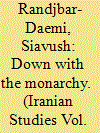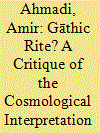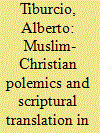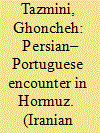|
|
|
Sort Order |
|
|
|
Items / Page
|
|
|
|
|
|
|
| Srl | Item |
| 1 |
ID:
151800


|
|
|
|
|
| Summary/Abstract |
For Kamyar Abdi
Many tribes lived in southwestern Persia during the Achaemenid period. The region was crucial for the Persian empire in that almost all roads connecting the two capitals of Persepolis and Susa run through it. The policy adopted by the Achaemenids for controlling this tribal region was to establish tribal confederations headed by men loyal to the king such as Madates and Gobryas. The Achaemenid king reinforced these tribal confederations by political marriages. Sisygambis, the mother of Darius III, was presumably an Uxian. This is why she was an ideal person to negotiate with Alexander of Macedon to free the Uxians headed by Madates, also probably an Uxian. Gobryas, the head of the Patischorian tribe, was one of the seven who rebelled against Bardiya/Gaumāta according to the Bisotun inscription and Herodotus. The Persepolis Fortification texts appear to show that the region between modern Bāsht and Ardakān called the Fahliyān region or Shulestān was the territory of this tribe. Irdabama, presumably the daughter of Gobryas born from his marriage with daughter of a local dynast, was married by Darius I in order to maintain Achaemenid control over this tribal region.
|
|
|
|
|
|
|
|
|
|
|
|
|
|
|
|
| 2 |
ID:
151802


|
|
|
|
|
| Summary/Abstract |
The death of the Persian dynast Rostam b. Farrokh-Hormozd at the Battle of al-Qādisiyyah during the Arab-Islamic conquest of Iran received much attention in both the Islamic conquest literature and the Persian epic tradition canonized in the Shāh-nāmeh. A careful examination of the narratives of early Islamic history teaches us much about the mindset of those living in the first centuries following the momentous events of the seventh century. By removing the layers of literary embellishment and moralistic exegesis, we can understand better the impact of the death of this Sāsānian dynast. In addition, by comparing the narrative traditions, we can uncover valuable testimony regarding the early development of what might later be described as an Islamic Iranian identity.
|
|
|
|
|
|
|
|
|
|
|
|
|
|
|
|
| 3 |
ID:
151805


|
|
|
|
|
| Summary/Abstract |
The purpose of this article is to explore and analyze Iran’s “Republican Moment” of 16‒19 August 1953, arguably the last concerted effort to abolish the monarchy and establish a republican order in the county prior to the Revolution of 1978‒79. By drawing on a broad range of primary source materials that have thus far remained relatively understudied by existing scholarship, such as the political press of those crucial days, the essay will attempt to shed light on a number of significant domestic developments which impacted the outcome of the actual coup of 19 August 1953. A further attempt will be made to explain the importance of calls in favor of the Republic and the premier Mohammad Mosaddeq’s refusal to take heed of them. The paper will also explore the diverse origins of the Republican platform and its impact on both the urban crowd and the political elite.
|
|
|
|
|
|
|
|
|
|
|
|
|
|
|
|
| 4 |
ID:
151801


|
|
|
|
|
| Summary/Abstract |
In the last few decades ritual interpretation of the Gāthās has replaced the biblical one as the dominant paradigm. The emphasis on the central role of ritual in the Avesta is well justified. This realization has given rise to the question of the role and meaning of ritual in the Gāthās. Marijan Molé had tried to argue that the Gāthās in fact describe and accompany a rite whose purpose was the preservation/renovation of the cosmic order. Students of the Gāthās working within the new paradigm have taken up Molé’s general frame. They have tried to show that the Gāthās, collectively or individually, is the text of a particular rite that served, among others, to preserve the cosmic order, especially the daily rise of the sun. The article questions the validity of this thesis. Its focus is on the version of the thesis we find in a number of recent publications by Jean Kellens. He tries to show that the first Gāthā (Ahunauuaitī) describes a unitary pre-dawn ritual that comprised a haoma rite and an animal sacrifice, and had cosmological and eschatological pretensions. His textual analyses and arguments are examined in some detail. The article concludes that Kellens's attempt must be deemed unsuccessful.
|
|
|
|
|
|
|
|
|
|
|
|
|
|
|
|
| 5 |
ID:
151803


|
|
|
|
|
| Summary/Abstract |
This article explores the work of ʿAli-Qoli Jadid al-Eslām (d. circa 1722), a Portuguese Augustinian missionary who embraced Islam during in the late seventeenth century. This investigation situates the work of this author within the social, political, and intellectual context of the late Safavid period. It traces the genealogy of his work as a response to the Jesuit missionary Jerome Xavier (d. 1617) and the Italian scholar Filippo Guadagnoli (d. 1656). The article examines how ʿAli-Qoli’s production fits within the genre of dalā’il al-nubuwwah, whereby the Bible is used as “proof” of the validity of Islam. It also analyzes the author’s use of common tropes of polemical literature, mainly that of accusing Christian scholars of practicing taḥrīf or scriptural tampering.
|
|
|
|
|
|
|
|
|
|
|
|
|
|
|
|
| 6 |
ID:
151804


|
|
|
|
|
| Summary/Abstract |
In 2015, the quincentennial commemoration of the Portuguese arrival on the island of Hormuz in the Persian Gulf (1515–1622) revealed the underlying presupposition among Iranians that the Portuguese presence on the island was the harbinger of a long-term pattern of western imperialism. This analysis questions the accuracy of this narrative by advancing a new interpretative framework that does not reduce the holding of Hormuz to simply another dark episode of European colonial history. Circumscribed and limited in aim and reach, Lusitanian activities on Hormuz cannot be brought under the generic rubric of “orientalism,” which is embedded in European colonial tradition, and which, by extension, buttresses Iranian nationalist sentiment about the Persian–Portuguese entanglement. This research demonstrates that Portuguese objectives diverged from the eighteenth and nineteenth century rationalist scientific traditions of the British, French and Germans professing a civilizing mission as a rationale for colonial policies. Whereas the Portuguese operated from a worldview that combined profit, dynastic pride and religious rhetoric, the Portuguese mission to Hormuz was not guided by a grand discourse of civilizing the “other.” While there was a complex interplay of commercial interests and brutal methods on this strategic entrepôt, Portuguese ambitions in Hormuz were confined and elusive, and at best a matter of tribute-taking. The present paper charters some of these complex interactions.
|
|
|
|
|
|
|
|
|
|
|
|
|
|
|
|
|
|
|
|
|